How to install and connect an air conditioner: detailed instructions + error analysis
The quality of installation determines 90% of the efficiency, uninterrupted operation and service life of the split system.In an effort to save money, many refuse the services of a qualified installation team, relying on their own skills.
In order not to spoil expensive equipment and realize the device’s full potential, before installing an air conditioner, you should understand its design, study the installation technology and outline the main stages of work.
We will try to help you resolve these issues. The article provides a diagram of the device of a household split, describes the principle of its operation, and also provides detailed instructions describing each technological stage of installing an air conditioner.
The experience of professionals has made it possible to identify typical mistakes of novice installers - these points should definitely be taken into account when attaching and connecting blocks.
The content of the article:
Typical device and principle of operation
An air conditioner is a technically complex piece of equipment. Individual models differ in the method of air supply, design features, power and other technical parameters. For detailed information about the types and selection of air conditioners, read this article.
A typical climate control system for a home is represented by a “bundle” of two elements – an outdoor and an indoor module.

To understand the principle by which air is cooled, you need to understand the main components split systems.
Components of the remote block:
- Fan – provides airflow to internal elements, in particular the condenser.
- Capacitor. In the radiator, the coolant is cooled, transferring heat to the outside air flow.
- Compressor - the heart of the refrigeration unit. The device is designed to compress and transmit freon along the circuit.
- Control system. On inverter models, the board is located in the external housing; in other air conditioners, the electronics are part of the internal unit.
Reversible split systems have a four-way valve (position 5 in the figure below), which changes the freon supply vector depending on the operating mode: “heating” or “cooling”.

The design of the indoor unit is somewhat simpler.
Main working units and parts:
- Front cover with louvers. Plastic perforated panel for supplying air inside the room. The grilles regulate the direction of air masses.
- Air filter. The polymer mesh and filter elements retain dirt particles. The degree of cleaning depends on the type of filter: carbon – removal of foreign odors, electrostatic – dust retention.
- Heat exchanger. Acts as an evaporator - freon is heated and evaporated here.
- Fan. It pumps air jets, redirecting them through the evaporator into the room. Several rotation speeds are possible.
On the front side of the device there is an indicator panel to display the operating mode and current microclimate parameters.

The principle of operation of the air conditioner is based on the transfer of heat from the room to the street. The system uses a unique property of the refrigerant - boiling at low temperatures.
Operating procedure in cooling mode:
- After turning on the split system, the gaseous substance is supplied to the compressor - here the freon is compressed and its temperature increases.
- The heated gas enters the heat exchanger of the external unit, where condensation occurs - transformation into a liquid state. The process is accompanied by cooling of the freon and transfer of heat to the outside.
- The refrigerant is directed to the internal heat exchanger. Following the capillary tube, the liquid is throttled - the pressure of the material decreases.
In the evaporator, the reverse process is observed - the incoming freon is blown with heat from the room and, when transitioning from a liquid state to a gas form, releases cold. Cooled air flows are supplied to the room.
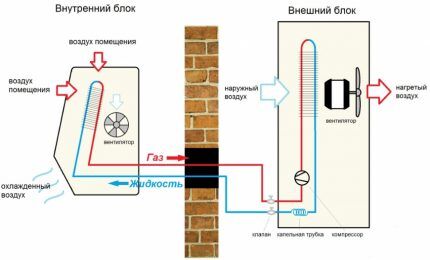
Requirements for placing a split system
The choice of location of air conditioning elements deserves special attention. A separate set of requirements and standards is devoted to the installation of the external unit, the internal casing and the length of the system pipe line.
Outdoor unit. When choosing an external unit, you should take into account the strength of the walls of the house.High-power models of air conditioners weigh up to 50-60 kg, standard household ones - 10-15 kg. In this case, the wall and the fastening elements used must have at least a double safety margin.
Installation nuances:
- It is extremely undesirable to install heavy devices on walls made of aerated concrete;
- installation of the block on a ventilated facade is carried out through a damping seal - the material reduces noise vibrations of the device;
- support brackets should be attached directly to the wall, and not to decorative cladding or insulation.
The location of the external housing is selected taking into account the following recommendations:
- The unit must be located in an area of free air circulation.
- An important condition is access to equipment for maintenance and repair.
- In the operating mode of the split system, hot air comes out of the compressor unit, so the unit is placed so that warm vapors do not enter the windows of neighbors on the lower floors.
The external element cannot be placed in an enclosed space, inside a glazed loggia or balcony. The minimum distance from each wall of the device to another dense surface is 30 cm.
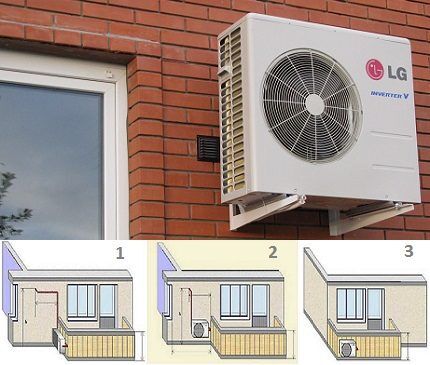
When installing an air conditioning system for an apartment on the ground floor, the height of the external unit is at least 2 m from the ground.
Indoor unit. The installation location must comply with technological standards, ensure comfortable use of the air conditioner and not stand out particularly against the background of the interior.
General requirements:
- The cooled air flow should not go directly to a person.It is better to avoid directing it to an area where you frequently stay - on a sofa, bed or workplace. Models with versatile air distribution direct jets along the walls.
- There should be no obstacles or objects in the path of the outgoing flow. It is unacceptable to install the evaporator unit in a niche - the cooling efficiency is reduced.
- The block hairdryer should not be placed above sockets and electrical appliances - if the drainage system is faulty, moisture can cause a short circuit and damage to the appliances.
When installing, make sure that the air intake openings do not overlap - installation close to a wall or ceiling is unacceptable.
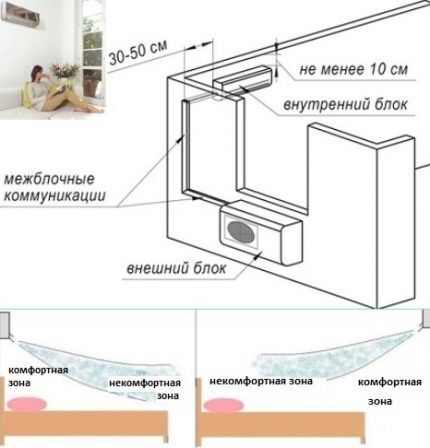
Route length. An important aspect of the system’s performance is the footage of the freon line - the distance between two blocks. The length of the route is indicated in the instructions for the equipment. The optimal parameter is 6 m, permissible distances: vertically – 7 m, horizontally – 15 m.
Removing blocks to the maximum distance is not recommended for a number of reasons:
- high cost of copper pipeline;
- when the freon line is lengthened, the load on the compressor increases - its power “weaken” and wear increases;
- The greater the length of the route, the greater the labor costs for its construction.
Very often, installers, in an effort to reduce the time it takes to complete the work, persistently suggest “cutting” the freon line. However, excessive shortening of the path affects the operation of the device.
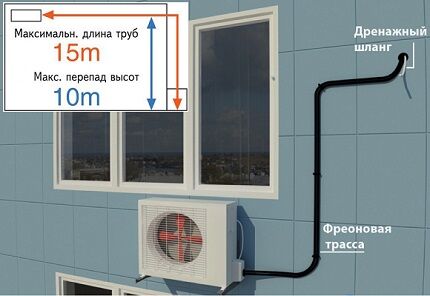
Step-by-step installation technology
Before installing a two-unit air conditioner, you should prepare the necessary tools and draw up a work plan. The general scheme of actions is as follows: drilling grooves and holes, installing the hair dryer panel and attaching the street module, supplying communications, vacuuming and starting the split system.
Selection of components and tools
Various manufacturers supply complete air conditioners with an installation kit. Providing the missing fasteners is the responsibility of the installer company.
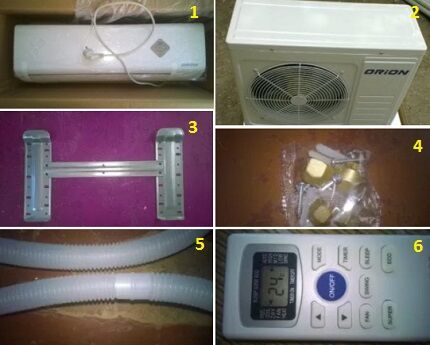
For self-installation you will need:
- copper tubes with a diameter of ¼ inch (liquid phase of freon), 3/8 inch (gase refrigerant) - the footage is selected in accordance with the length of the freon route plus 1 m of reserve;
- nuts for joining pipes;
- thermal insulation sleeves made of foamed polymer;
- reinforced tape;
- anchor screws (diameter 10-12 mm, length - 150-300 mm) and brackets.
A power outlet is required to power the units. It is optimal if it is connected to a separate VVGng 3*2.5 mm cable from a separate electrical panel. It is advisable that the cable be protected circuit breaker.
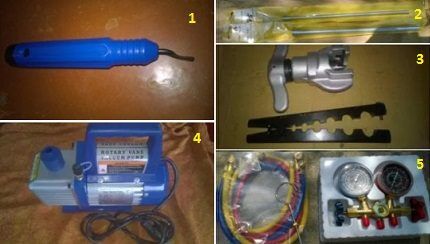
In addition to the tools listed above, you will need: a hammer drill and drills of different sizes, screwdrivers, open-end wrenches, wire cutters, crimper and wire strippers.
Preparation of communication channels
The first step is to note the location for installing the hairdryer unit, the path of the freon circuit and the location of the through hole.
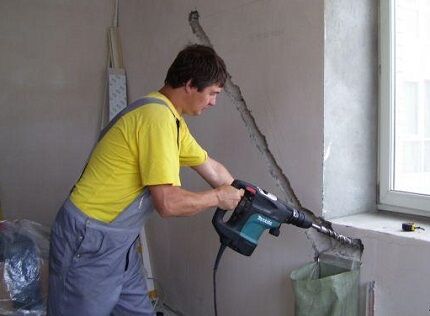
To exit pipes and cables, a hole with a diameter of 50 mm is drilled with a slight slope towards the street - this will ensure free drainage of condensate. Under the wires you need ditch the wall or use camouflage pads.
A sleeve (plastic pipe) must be inserted into the passage “window”, which reduces the risk of damage to communications.
Attaching the Mounting Panel
The base for installing the hair dryer unit is attached strictly horizontally so that liquid from the drainage container does not pour into the room, but is discharged through the drainage channel to the street.
In addition, a skewed air conditioner looks ugly.
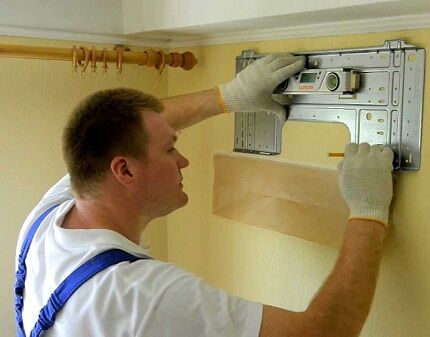
Mounting plate attachment:
- From the back of the inner case, remove the steel panel by bending the latches.
- Place it on the wall and align it horizontally.
- Mark places for fasteners, drill holes, install dowels.
- Secure the panel.
The mounting plate has many pre-drilled holes. To fix the base for the block, it is enough to use six of them - more convenient in a particular case.
Installation of an external split unit
Installing a street block on a façade wall involves risky high-rise work. Manual installation is permissible only on the lower floors of high-rise buildings or in private one-story houses.
Even in these situations, it is necessary to enlist the support of an assistant and follow safety precautions - work with insurance. To install the external module at a height, you must invite an industrial climber.
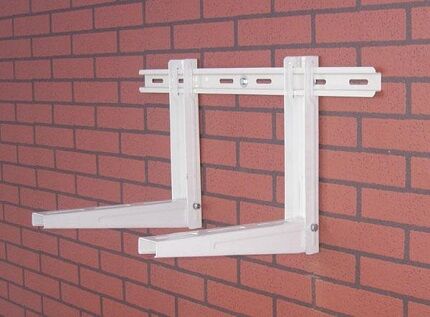
Requirements for brackets:
- Integrity of the paint layer. Coating material – powder paint without scratches or chips. The enamel will not withstand mechanical stress, and the damaged areas are susceptible to corrosion - over time, the fasteners lose their strength.
- Holes for oval anchors. Drilling additional openings is unacceptable, as the design safety factor is reduced and the paint is removed.
The load capacity of the support is indicated on the bracket body. The distance between the two “beams” is calculated so that the openings in the supports coincide with the holes for fixing on the external module.
Work progress:
- Secure the brackets using long anchors and screws with a diameter of 10-12 mm. There are at least three fasteners for each support.
- Place rubber pads - vibration isolators - under the legs of the split block.
- Lower the module onto the brackets.
Pass the anchors through the seal, the holes in the supports, and the legs of the block and tighten them tightly. The diameter of the mounting bolts is 8-10 mm.
Supply of copper tubes and cables
Next, you should measure the length of communications from the indoor module to the terminals and valves on the outdoor unit. Cut the required length of wire and strip it.
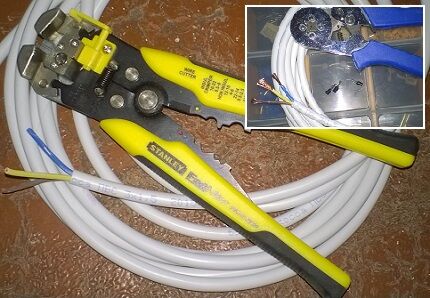
Preparation and installation of the freon line:
- Cut and strip two identical sections of pipe. Remove chips and wipe the ends.
- Place a union nut on the tube and flare it.
- Bend the tubes coming from the internal module and screw them with nuts onto the nipples. Tighten the nuts.
- Put on the insulating cover.
- If necessary, extend the drainage outlet.
- Assemble the cables and tubes and wrap them with tape. Place plugs on the copper tubes and place the drainage channel at the bottom of the bundle.
- Pull the communication “node” through the hole in the wall.
- Hang the hair dryer unit onto the mounting plate.
- Use a pipe bender to give the route the desired shape, avoiding sharp corners.
- Connect the pipes to the valves - with a larger diameter for the gas valve, and a smaller diameter for the liquid one. If necessary, trim off excess.
- Put on thermal insulation and flare the tubes.
Before connecting and testing the air conditioner, you need to check the tightness of the line. Perform pressure testing of the pipes and check the pressure stability in the system with a pressure gauge.
Evacuation of the refrigeration circuit
A mandatory step is creating a vacuum in the system. The procedure allows you to eliminate air and moisture from the line. A pump and a pressure manifold are used for operation.
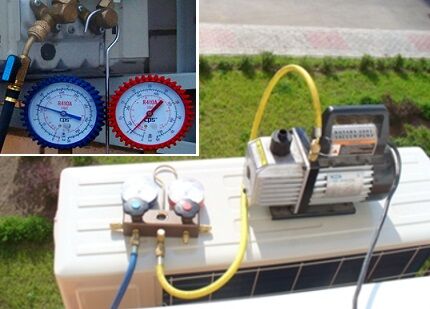
The procedure for vacuuming the system:
- Close the valves on the pressure gauge.
- Start the vacuum pump, open the pressure gauge valve - after a minute, the device will show a zero value.
- Continue vacuuming to remove moisture from the system. Working time – 15-30 minutes.
- Close the valve and turn off the pump.
An increase in pressure after turning off the pump indicates the presence of leaks and leaks in the circuit.
Filling the line with freon
Final stage – refrigerant start and checking the performance of the air conditioner. A certain volume of freon must circulate in the circuit to maintain the pressure specified by the manufacturer.
When extending the line, refueling with this substance is required.

After refueling, you need to disconnect the hose from the “gas” valve. You should take precautions - wear glasses, gloves and do not tilt your face towards the unscrewed fitting. To minimize freon losses, you need to act quickly.
You must be prepared for the fact that unscrewing the fitting is accompanied by hissing and the release of oil and freon. An uninformed person may suddenly withdraw his hand and release the refrigerant. In addition, there is a risk of thermal burns.
Before starting the split system for the first time, you need to check the connections of the route for leaks (wash them), tighten the plugs of the service port and valves. Now you can plug in the air conditioner and test its performance.
Typical mistakes in installing an air conditioner
Failure to comply with installation requirements is a common cause of failures in the operation of split systems and an unreasonable increase in electricity bills. Here is a list of popular shortcomings.
№1. Installation in an inappropriate location. The requirements for the placement of split units were discussed above. Inexperienced craftsmen make standard mistakes: installation above a heating device or in an area of direct exposure to sunlight.
№2. Poor quality rolling.
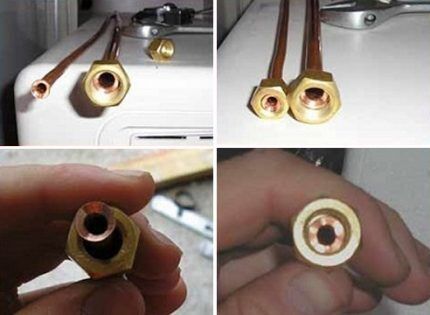
№3. Discrepancy between the volume of refrigerant and the length of the route. The amount of freon is directly proportional to the footage of the circuit. If the line is increased/decreased, but its volume is not adjusted, then the air conditioner does not work correctly and eventually fails.
№4. Lack of thermal insulation. The hole in the wall for laying the line must be filled with foam. If this is not done, temperature changes will provoke the appearance of condensation - the settling of moisture on the concrete will lead to the formation of fungus.
№5. Broken copper tubes.
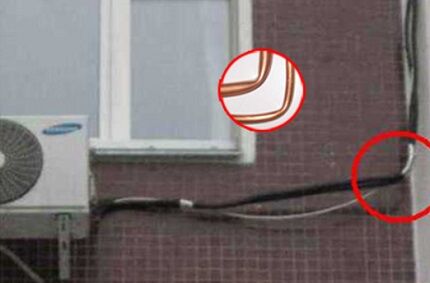
№6. Unreliable cable connection. Errors in electrical wiring can result not only in damage to the climate control equipment, but also in fire or electric shock.
№7. Use of low-quality materials. Fragile brackets may not be able to cope with the imposed load, especially in winter when snow accumulates on the split block. Preventive measures: choosing a reliable support and installing a protective canopy over the street block.
Conclusions and useful video on the topic
A detailed video will help you understand the technological nuances of installing an air conditioner in an apartment.
The instruction contains a list of necessary tools, shows the process of installing split units, organizing cable channels, connecting communications and putting the air conditioner into operation:
The main difficulty in installing an air conditioner is installing a heavy unit on the facade of a high-rise building. It is better to use the services of an industrial climber.The remaining actions do not require any special skills; the main thing is to follow the installation technology and the recommendations of the split manufacturer.
Do you have personal experience installing an air conditioner? Do you want to share your accumulated knowledge or warn readers against possible installation and connection errors? Please leave comments and participate in discussions - the feedback form is located below.




Yes, a lot depends on how firmly the air conditioner is attached to the wall outside. I had a “master” install it, and two weeks later the bracket on the left side came off - surprisingly, the right one coped with the load placed on it. It's good that it all ended this way. What if he fell down and, for example, fell on someone’s car? So keep an eye on this.
Based on the information you provided, you can open your own installation service! It’s good that you provided an image of the design and operating principle of the air conditioner. I wonder if industrial air conditioners are installed using this method? It would be nice to add a couple of paragraphs here about troubleshooting. Perhaps I will follow the advice of the previous commentator and will monitor the installation of the climate control unit so that the work is carried out according to the rules.
Industrial air conditioners, Sergey, are installed based on the developed project.
One section is devoted to the number of outdoor units that provide the required cooling capacity, another to the placement of indoor units, the third to communications, and the fourth to automation that links the operation of the components. To give an idea of the system, I have attached a screenshot of the external units placed on the roof of the building.
In case of malfunctions, Sergey, a modern air conditioner alerts the owner. The electronic display displays “error codes”. For example, I attached a screenshot of Daikin. After looking, you will understand that it is useless to write a separate article for amateurs, but masters are provided with manuals.